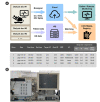System of integrating biosignals during hemodialysis: the CONTINUAL (Continuous mOnitoriNg viTal sIgN dUring hemodiALysis) registry
- PMID: 35698753
- PMCID: PMC9184839
- DOI: 10.23876/j.krcp.21.157
System of integrating biosignals during hemodialysis: the CONTINUAL (Continuous mOnitoriNg viTal sIgN dUring hemodiALysis) registry
Abstract
Background: Appropriate monitoring of intradialytic biosignals is essential to minimize adverse outcomes because intradialytic hypotension and arrhythmia are associated with cardiovascular risk in hemodialysis patients. However, a continuous monitoring system for intradialytic biosignals has not yet been developed.
Methods: This study investigated a cloud system that hosted a prospective, open-source registry to monitor and collect intradialytic biosignals, which was named the CONTINUAL (Continuous mOnitoriNg viTal sIgN dUring hemodiALysis) registry. This registry was based on real-time multimodal data acquisition, such as blood pressure, heart rate, electrocardiogram, and photoplethysmogram results.
Results: We analyzed session information from this system for the initial 8 months, including data for some cases with hemodynamic complications such as intradialytic hypotension and arrhythmia.
Conclusion: This biosignal registry provides valuable data that can be applied to conduct epidemiological surveys on hemodynamic complications during hemodialysis and develop artificial intelligence models that predict biosignal changes which can improve patient outcomes.
Keywords: Biosignal; Cardiac arrhythmias; Hypertension; Hypotension; Renal dialysis.
Conflict of interest statement
All authors have no conflicts of interest to declare.
Figures





Similar articles
-
Intradialytic changes of serum magnesium and their relation to hypotensive episodes in hemodialysis patients on different dialysates.Hemodial Int. 2006 Oct;10 Suppl 2:S16-23. doi: 10.1111/j.1542-4758.2006.00120.x. Hemodial Int. 2006. PMID: 17022745
-
Evaluation of peripheral perfusion index and heart rate variability as early predictors for intradialytic hypotension in critically ill patients.BMC Anesthesiol. 2019 Dec 27;19(1):242. doi: 10.1186/s12871-019-0917-1. BMC Anesthesiol. 2019. PMID: 31881971 Free PMC article.
-
Evaluation of intradialytic hypotension using impedance cardiography.Int Urol Nephrol. 2011 Sep;43(3):855-64. doi: 10.1007/s11255-010-9746-3. Epub 2010 May 7. Int Urol Nephrol. 2011. PMID: 20449654 Clinical Trial.
-
Intensive Hemodialysis and Treatment Complications and Tolerability.Am J Kidney Dis. 2016 Nov;68(5S1):S43-S50. doi: 10.1053/j.ajkd.2016.05.021. Am J Kidney Dis. 2016. PMID: 27772642 Review.
-
Eating during the Hemodialysis Session: A Practice Improving Nutritional Status or a Risk Factor for Intradialytic Hypotension and Reduced Dialysis Adequacy?Nutrients. 2020 Jun 6;12(6):1703. doi: 10.3390/nu12061703. Nutrients. 2020. PMID: 32517256 Free PMC article. Review.
Cited by
-
Real-time dual prediction of intradialytic hypotension and hypertension using an explainable deep learning model.Sci Rep. 2023 Oct 23;13(1):18054. doi: 10.1038/s41598-023-45282-1. Sci Rep. 2023. PMID: 37872390 Free PMC article.
-
Automatic segmentation of atrial fibrillation and flutter in single-lead electrocardiograms by self-supervised learning and Transformer architecture.J Am Med Inform Assoc. 2023 Dec 22;31(1):79-88. doi: 10.1093/jamia/ocad219. J Am Med Inform Assoc. 2023. PMID: 37949101 Free PMC article.
References
-
- Liyanage T, Ninomiya T, Jha V, et al. Worldwide access to treatment for end-stage kidney disease: a systematic review. Lancet. 2015;385:1975–1982. - PubMed
-
- Davenport A. Intradialytic complications during hemodialysis. Hemodial Int. 2006;10:162–167. - PubMed
-
- Ritz E, Bommer J. Cardiovascular problems on hemodialysis: current deficits and potential improvement. Clin J Am Soc Nephrol. 2009;4 Suppl 1:S71–S78. - PubMed
LinkOut - more resources
Full Text Sources

